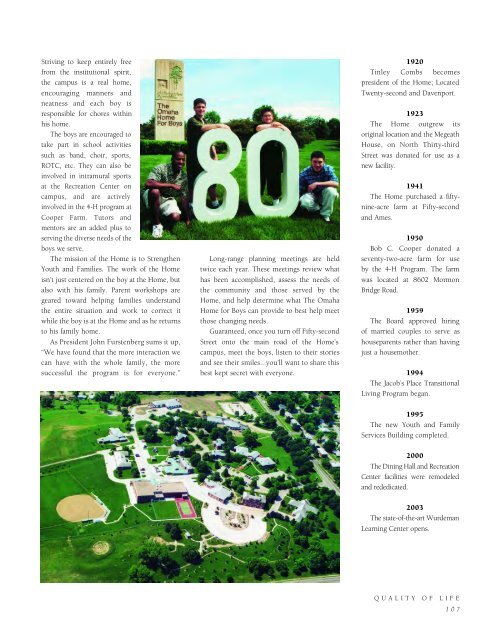Historic Omaha
An illustrated history of Omaha and the Douglas County area, paired with the histories of companies, families and organizations that make the region great.
An illustrated history of Omaha and the Douglas County area, paired with the histories of companies, families and organizations that make the region great.
You also want an ePaper? Increase the reach of your titles
YUMPU automatically turns print PDFs into web optimized ePapers that Google loves.
Striving to keep entirely free<br />
from the institutional spirit,<br />
the campus is a real home,<br />
encouraging manners and<br />
neatness and each boy is<br />
responsible for chores within<br />
his home.<br />
The boys are encouraged to<br />
take part in school activities<br />
such as band, choir, sports,<br />
ROTC, etc. They can also be<br />
involved in intramural sports<br />
at the Recreation Center on<br />
campus, and are actively<br />
involved in the 4-H program at<br />
Cooper Farm. Tutors and<br />
mentors are an added plus to<br />
serving the diverse needs of the<br />
boys we serve.<br />
The mission of the Home is to Strengthen<br />
Youth and Families. The work of the Home<br />
isn’t just centered on the boy at the Home, but<br />
also with his family. Parent workshops are<br />
geared toward helping families understand<br />
the entire situation and work to correct it<br />
while the boy is at the Home and as he returns<br />
to his family home.<br />
As President John Furstenberg sums it up,<br />
“We have found that the more interaction we<br />
can have with the whole family, the more<br />
successful the program is for everyone.”<br />
Long-range planning meetings are held<br />
twice each year. These meetings review what<br />
has been accomplished, assess the needs of<br />
the community and those served by the<br />
Home, and help determine what The <strong>Omaha</strong><br />
Home for Boys can provide to best help meet<br />
those changing needs.<br />
Guaranteed, once you turn off Fifty-second<br />
Street onto the main road of the Home’s<br />
campus, meet the boys, listen to their stories<br />
and see their smiles...you’ll want to share this<br />
best kept secret with everyone.<br />
1920<br />
Tinley Combs becomes<br />
president of the Home; Located<br />
Twenty-second and Davenport.<br />
1923<br />
The Home outgrew its<br />
original location and the Megeath<br />
House, on North Thirty-third<br />
Street was donated for use as a<br />
new facility.<br />
1941<br />
The Home purchased a fiftynine-acre<br />
farm at Fifty-second<br />
and Ames.<br />
1950<br />
Bob C. Cooper donated a<br />
seventy-two-acre farm for use<br />
by the 4-H Program. The farm<br />
was located at 8602 Mormon<br />
Bridge Road.<br />
1959<br />
The Board approved hiring<br />
of married couples to serve as<br />
houseparents rather than having<br />
just a housemother.<br />
1994<br />
The Jacob’s Place Transitional<br />
Living Program began.<br />
1995<br />
The new Youth and Family<br />
Services Building completed.<br />
2000<br />
The Dining Hall and Recreation<br />
Center facilities were remodeled<br />
and rededicated.<br />
2003<br />
The state-of-the-art Wurdeman<br />
Learning Center opens.<br />
QUALITY OF LIFE<br />
107
















